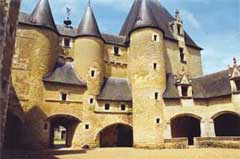The “Langue d’Oc” And The “Langue d’Oil”
The Langue d’Oc and the Langue d’Oil are the two principal groups of dialects spoken in medieval France. A geographical separation between the two can be drawn as a line going from Bordeaux to Grenoble, with the Langue d’Oc spoken south of it.
The Langue d’Oc evolved into the Occitan language, and the language of the troubadours, the Provençal (the language of Provence) , is actually part of the Occitan.
The Langue d’Oc, described sometimes as Provençal, was practically the language of the whole of the south of France. Going into a detailed geographical description, the area of its prevalence might be indicated by drawing a line from the mouth of the Garonne to the Alps, which would include within its limits the provinces of Guienne, Gascony, Beam, Foix, Roussillon, Languedoc, Dauphiné, Auvergne, part of Lyonnais, Limousin, part of Marche, Angouléme, Saintonge, and Poitou, with Provence itself.
The difference between these languages can be best characterized and comprehended by reference to the classification of Dante, which divides the Romance languages into three groups. The groups are distinguished from one another by the difference of the word expressing “yes.”
In one set of dialects “yes” was Oc, in another was Oil, and in another it was Si. The three languages were accordingly described as the Langue d’Oc, the Langue d’Oil, and the Lingua di Si. The Langue d’Oc reffered to the Provençal, the Langue d’Oil to the Northern French, and the Lingua di Si to Italian.
The physical and social characteristics of the people inhabiting the regions in the South have always been similar, impressed by nature, and led to their grouping in an exclusive category, irrespectively of the temporary political domination.
The Romans noticed the racial similarity from the very beginning. They considered it when constituting their province (provincia), and included the inhabitants of the whole of the South of France from the Alps to the Pyrenees in its natural limits.
In a similar manner, the medieval geographers were used to style by the term provinciales, or Provençale, not only the inhabitants of Provence proper, but those of Languedoc, Aquitaine, and all the others in the provinces enumerated above. Remarkably, the geographers did this despite the territories being governed by different rulers and holding allegiance to different kings.
Within the large district of the Langue d’Oc, the community of language resulted in community of thought and custom. The manners in the centre of Provençal vitality, which was Provence itself, were immitated in the whole of that vast region. Despite the fact that the identity of political association was not achieved, the one language and spirit led to the more complete and intimate union of feeling and nature.
Within their castles, the sophisticated seigneurs of Provence were seeking isolation from the vulgar, and promoted arts, poetry and songs. Based on a common spirit, they were imitated by their fellow Provençal nobles of Aquitaine, Limousin, Auvergne, Saintonge, Poix, Roussillon.
In their ambition to equal them in refinement and aristocratic taste, they equally promoted the Langue d’Oc as the langue of the troubadours.

